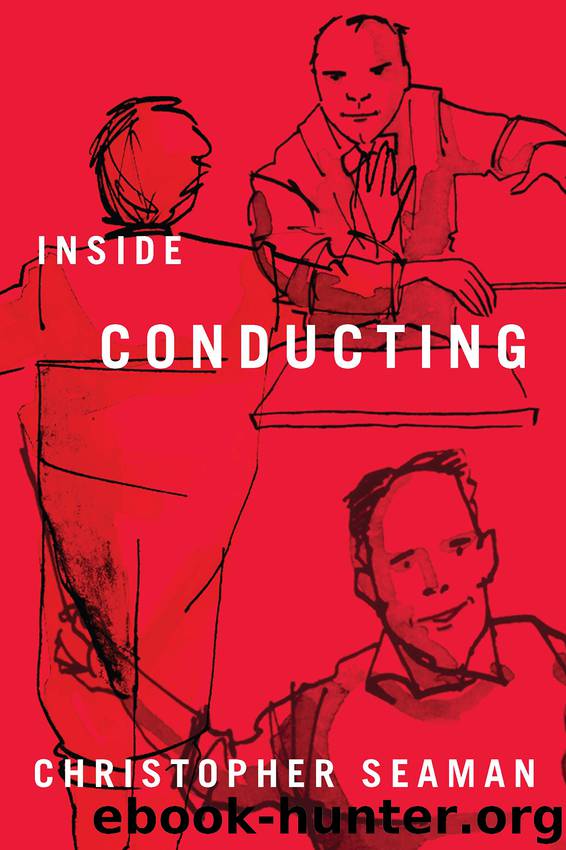Inside Conducting by Christopher Seaman

Author:Christopher Seaman
Language: eng
Format: epub
Publisher: Boydell & Brewer Group Ltd
Published: 2013-05-22T16:00:00+00:00
Figure 4.
Figure 5.
The placing of the timpani and percussion depends on the shape of the platform. They all need to hear the woodwinds and brass clearly; in Classical works the timpani mostly play the same notes as the trumpets. Sometimes they’re placed at the back, behind the brass, and sometimes over to the right or the left; it depends on space and acoustics. As a timpanist I hated sitting where I couldn’t hear the brass.
The principal cello and principal bass shouldn’t be too far apart, because the two sections play together so much. I like to bring the first stand of basses well forward so the section is in a wedge-shaped formation. This gives me good contact with the principal bass, a key person for the entire orchestra’s ensemble. At one time it was common to have the double basses at the very back, behind the wind instruments, and a few orchestras still use that setting. It enables a wind section to hear the bass line, but it puts the basses a long way from the cellos. Its success depends on the clarity of a hall’s acoustics and the ability of the principal double bass.
Some wind sections sit on risers, like steps going up to the back, while others sit on the flat stage. In most halls the players project better if they’re higher, but if the “steps” are too steep, players can’t hear the row in front, which is bad for ensemble and tuning. There’s also the visual aspect: an audience likes to see as many of the winds and percussion as possible. If you can see a player, you feel you’re hearing him better. I usually find it harder to hear the woodwinds when they’re on the flat stage, while they find it harder to hear the strings.
I remember a London Philharmonic rehearsal in a provincial venue where we were all sitting on the flat stage. The English conductor complained that he couldn’t hear the horns and wanted them seated on risers. He turned to the auditorium and shouted, “Podia! Bring me podia!” The staff worked out what “podia” meant, rummaged around, and found some boxes for the horns. This took ten minutes of valuable rehearsal time. We tried again. “Horns, I still can’t hear you,” he complained, and turned around calling for “higher podia.” These were duly provided, and we tried a third time. “Horns, I still can’t hear you!” he moaned. The fourth horn (a quiet Scotsman) asked, “Would it be easier if we just played a wee bit louder?”
Seating the last few stands of strings on risers helps their sound project. Some orchestras even manage to have each stand progressively higher, like a flight of steps. This helps the sound and enables the players at the back to see and hear the front stands. Local fire regulations may preclude such risers, though, because they get in the way of a quick exit.
The harp is placed between the first and second violins, upstage of the back of the seconds, or occasionally on the conductor’s right, in front of the basses.
Download
This site does not store any files on its server. We only index and link to content provided by other sites. Please contact the content providers to delete copyright contents if any and email us, we'll remove relevant links or contents immediately.
| Biographies | Business |
| History & Criticism | Instruments |
| Musical Genres | Recording & Sound |
| Reference | Songbooks |
| Theory, Composition & Performance |
The Goal (Off-Campus #4) by Elle Kennedy(12460)
Kathy Andrews Collection by Kathy Andrews(10565)
Diary of a Player by Brad Paisley(6872)
What Does This Button Do? by Bruce Dickinson(5539)
Assassin’s Fate by Robin Hobb(5257)
Big Little Lies by Liane Moriarty(4895)
Pale Blue Dot by Carl Sagan(4024)
Sticky Fingers by Joe Hagan(3461)
The Heroin Diaries by Nikki Sixx(2943)
The Death of the Heart by Elizabeth Bowen(2916)
Beneath These Shadows by Meghan March(2732)
The Help by Kathryn Stockett(2711)
Confessions of a Video Vixen by Karrine Steffans(2686)
How Music Works by David Byrne(2542)
Jam by Jam (epub)(2499)
Harry Potter 4 - Harry Potter and The Goblet of Fire by J.K.Rowling(2423)
Strange Fascination: David Bowie: The Definitive Story by David Buckley(2372)
Petty: The Biography by Warren Zanes(2242)
Darker Than the Deepest Sea by Trevor Dann(2215)
